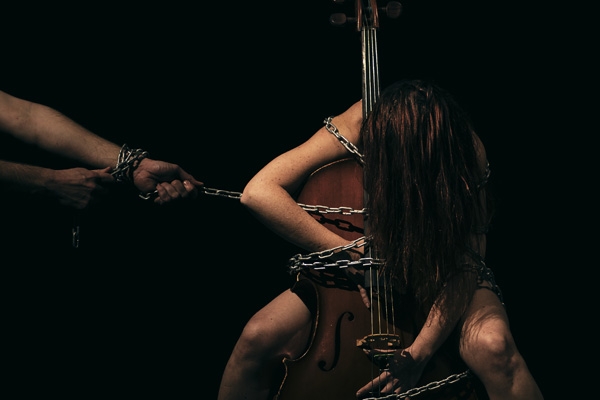'The Human Detained' is a collaboration between two Brisbane contemporary performance groups: music ensemble, Kupka's Piano and MakeShift Dance Collective. It presents four world premieres of new works by young Brisbane composers Steve Newcomb, Michael Mathieson-Sandars, Samantha Wolf and Brodie McAllister.
That introduction would generally polarize readers into the keen and the not-for-me camps; but this performance is short and fairly snappy (lasting about an hour in total) and if you have ever wondered what contemporary music and dance might do for you, this type of performance be a good place to start. The four short compositions are enclosed in shorter interludes, giving nine varied musical pieces most with movement choreographed to them; and these bite-sized offerings, with the 'human detained' theme woven through the main compositions, were generally engaging and thought-provoking.
The theme had different foci for the four pieces. The first was entitled 'Kicking Gaols' and created a soundscape that used metallic instruments to envoke prison bars, with the dancer starting enclosed behind the vibraphone. The instruments were evocative but the Boggo Road soundtrack (complete with people saying 'good bye' after a tour) felt like a distraction – a potentially good idea that couldn't be dropped. The soundtrack also featured shuffling, zipping, and crackling sounds; and while the dancer's ability to synchronise movements to them was admirable, they hampered rather than enhanced the piece.
'Thin Lines Of Ours' is described as being about the pursuit of balance – internal and external – between honesty and expectation. It was an impressive instrumental composition for electronic clarinet that conveyed struggle and polarities and was accompanied by a fluid and energetic solo male dance, creating a captivating unified whole. The exception was the interaction between the artists. In all compositions the musicians and dancers interacted (and the themes can explain why that might be so) but in the first two the interaction wasn't sufficiently integrated into the whole, leaving a vague sense of unintentional disruption.
The interludes were fundamental in keeping coherence and atmosphere; providing stepping-stones between the main compositions. Sometimes reflective, sometimes relieving, and at the end a rousing send off. I particularly enjoyed Interlude II where the musicians and dancers used whirly tubes to generate both visual and musical form.
'The Binds That Tie Us' started with a dramatic scene between female dancer and male musician seated at either end of a table with a bowl of egg shells as the currency of their interaction. Initially the musician was little-involved in the music production and so was able to attend to the reflective game and exchange of eggs, but as the music required more attention he struggled to do both, which the audience found amusing (but was unsure whether it was meant to be). The dancer then got up, arranged and danced within and around the egg shells, creating patterns that suggested different constraints. This piece was conceptually and artistically interesting, exploring the 'human detained' by the 'trivial, self-inflicted or intangible'. Additionally it taught me what a variety of sounds can be made with egg shells!
The final composition was 'For Reza Berati' and this spoke most directly about literal human detention. It started with the transformation of the final image from 'Interlude III', of two dancers standing aside another on the floor, into them detaining her. She struggled free only to thresh within the lit box of the stage between the violin and flute. The instruments question and answer communication gradually became interspersed with emerging words that were finally heard as "no prison", "no fear". It was perhaps fitting to be ultimately reminded that our personal detentions are overshadowed by, and perhaps need to be overcome to protest against, more violent and concrete human detention.
The programme notes are always key in such performances when seeking to understand what the artists want to say (and I'd like more on how the creative process unfolded for these compositions). But just letting the sound and visual imagery permeate can be equally powerful and rewarding. So if you have a flickering of interest in contemporary dance and music keep an eye open for their future offerings.






